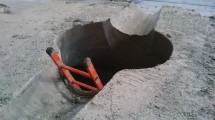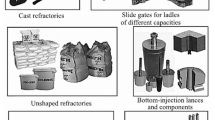Abstract
The main fields of application of refractory castables (LCC) of the new generation in ferrous metallurgy are considered and classified in accordance with the content of CaO in them
Similar content being viewed by others
References
J. Brigg, “European and international refractories industry: A market,” in:Technology Report, UK (1998).
C. E. Semler, “Refractories industry. Status and trends,”Industrial Minerals, No. 356, 29–37 (1997).
S.Kataoka, “Refractories for steelmaking in Japan,” in:Unitecr’95 Congress, 19–22 November 1995, Vol. 1, pp. 1–27.
W. E. Lee and R. E. Moore, “Evolution of in situ refractories in the 20th century,”J. Am. Ceram. Soc.,81(6), 1385–1410 (1998).
T. Kendall, “Lafarge refractories monolithiques,”Industrial Minerals, No. 360, 101–107 (1997).
Yu. E. Pivinskii, “Refractory concretes of the new generation, Colloidal-chemical aspect of the technology,”Ogneup. Tekh. Keram., No. 1, 4–12(1994).
Yu. E. Pivinskii, D. A. Dobrodon, I. V. Galenko, et al., “Materials based on highly concentrated ceramic binding suspensions (HCBS). Comparative characteristic of properties and service stability of socket blocks of intermediate ladles,”Ogneup. Tekh. Keram., No. 9, 33–36 (1997).
V. V. Primachenko, “A study of the formation of coagulation structures in vibrocast large-grain thixotropic mixtures,”Ogne- upory, No. 5, 2–5 (1994).
L. M. Aksel’rod, I. V. Egorov, and N. A. Chuprina, “Low-cement refractory concretes of corundum and alumina-silicate compositions,”Ogneup. Tekh. Keram., No. 9, 40–42 (1998).
1998 Annular Book of ASTM Standards, Section 15, V. 15.01,Designation: C 401-91 (Reapproved 1995). Standard: Classification of Alumina and Alumina-Silicate Castable Refractories.
European Prestandard ENV 1402-1. August 1994, Unshaped Refractory Products. Part 1: Introduction and Definitions.
X. C. Zhong, “Refractories developments for iron and steelmaking in China,” in:Unitecr ’95 Congress, 19–22 November 1995, Vol.1, pp. 75–85.
Tabular Alumina T-60. Magnesium Aluminate Spinels. Calcined and Reactive Aluminas for Refractories. Calcium Aluminate Cements, Prospectuses of Alcoa Industrial Chemical Europe Company.
I. N. Chakraborty, and A. K. Chattopadhyay, “Brown tabular alumina — A high performance refractory aggregate for slag and chemical attack resistant formulations,” in:Acc Refractories, Tata Press (1993).
Blast Furnace Refractories, Technical Information “K.S.R. International Ltd.”
Prospectus of “Veitcher,” Eisen und Stahl (1995).
Refractory Products and Services, Prospectus of Didier Werke Company (1994/1995).
P. G. Whiteley, “Challenge to refractories industry,” in:40 Int. Colloquium on Refractories 30.09–01.10.97, Aachen, pp. 16–21.
“Monolithic refractories in the steel plant of Voest-Alpine Stahl Linz.,” in:Unitecr ’97, 5th Biennial Worldwide Cong. “Refractories — a Worldwide Technology,” Vol. 1, New Orleans,4 –7 November, 1997, pp. 255–264.
M. W. Vance, G. W. Kriechbaum, R. A. Henrichsen, et al., “Influence of spinel additives on the performance of high alumina and spinel castables,” in:Tech. Bull. “Alcoa Industrial Chemicals,” November 1994.
Ladle furnace and refining ladles, Prospectus of the RADEX Company.
Electrical arc furnace, Prospectus of the RADEX Company.
S. Itose, T. Isobe, K. Sugiyata, and K. Furukawa, “Optimum castable lining for steel ladle in Japan,” in:Unitecr’97, 5th Biennial Worldwide Congr. “Refractories — a Worldwide Technology,” Vol. 1, New Orleans, 4–7 November 1997, pp. 175–181.
A. Hey, S. J. Gregory, G. S. Hutchesson, et al., “Applications of engineered castable systems to refractory linings in the steel industry,” in:39 Int. Colloq. on Refractories, Aachen, 24 –25 September, 1996.
Steelmaking industry, Monolithic lining of ladles, Information of the Basalt-Feuerfest GmbH (1997).
Yu. E. Pivinskii, “New castables and binding systems: Basic direction in the development and use of refractories in the 21 st century. Part III. Spinel and cast (self-flowing) castables,”Ogneup. Tekh. Keram., No. 4, 12–18 (1998).
M. Yamasaki, K. Ariyoshi, M. Koyamata, and M. Nayashi, “Effect of MgO component on the quality of the alumina-magnesia castable,”Taikabutsu,48(8), 430–431 (1996).
Materials of Seminar of Alcoa Industrial Chemical Europe Company [in Russian], Moscow, (1998).
M. Nanda, “Thermal properties of castable for teeming ladle,”Taikabutsu,46(11), 559 (1994).
Y. Ochiai, K. Mathio, R. Ohima, and A. Ohte, “Application of alumina-spinel castable for the bottom of steel ladle,”Taikabutsu,46(11), 558 (1994).
K. Mori, Y. Toritani, and S. Tanaka, “Development of alumina magnesia castable for steel ladle,” in:Unitecr ’95 Congr., Kyoto (Japan), 19 –22 November, 1995, pp. 171–178.
K. Furuta, K. Ido, Y. Kawase, et al., “Development of castable refractories for steel ladle bottom,”Taikabutsu,47(10), 501–502(1995).
B. Stenly and S. B. Lansday, “Development of cement free castables and monolithic refractory installation,”Industrial Heating,64(12), 55–57 (1997).
Products for steel casting and treatment ladles, Veitscher Company Information.
T. Katsuhiro, “The latest trends for continuous casting refractories in Japan,”Shinagawa Tech. Rep.,36, 1–55 (1993).
Endiess lining, Didier Information, No. 2 (1995).
A. Bunhr, “Tonerdereiche Feuerfestbetone für den Einsatz in der Stahlindustrie,“Stahl und Eisen, 59–66 (1996).
Refractory products and services, Didier-Werke AG Information (1995/1996).
H. Leopold and G. H. Vermier, “Gibbsitischer Fewerfester Bauxit aus der Jariregion, Brasilien,”Veitsch-Radex Rundshaum,1, 16–33(1996).
J. Broun, “Cast permanent lining extends tundish service life,”Am. Ceram. Soc. Bull.,71(10), 1503–1506 (1992).
Y. Nakashima, E. Konishi, and S. Subo, “Application of self-flow type castable in refractories NKK,” in:Unitecr’95 Congr., Kyoto (Japan), 19–22 November 1995, Vol. 2, pp. 205–213.
K. Sakakidani, K. Fujii, and M. Tawara, “Improvement of tundish inner lining refractory,”Ibid. Unitecr’95 Congr., Kyoto (Japan), 19–22 November 1995, Vol. 2, pp. 125-132.
H. Shinagawa, T. Hara, L. Tsura, and K. Sakakudani, “Repeated use of permanent layer of tundish ladle lining with the use of unshaped refractory material,”Taikabutsu,48(12), 662–663 (1996).
M. W. Vance and K. I. Moody, “Steelplant refractories containing alphabond hydrateable alumina binders,”Ref. Appl,2(3), 2–6(1997).
S. N. Lana, “Development of monolithic lance for rinsing liquid steel in India,” in:Unitecr’93 Int. Congr., San Paulo (Brazil), pp. 595–608.
T. Matsui, K. Kasai, J Yanada, et al., “Improved peeling resistance of lance castable for pre-refinement of molten iron,”Taikabutsu,48(8), 420–421 (1996).
N. Cassens, R. A. Steince, and R. V. Videtto, “Shotcreting self-flow refractory castable,” in:Unitecr’97, 5th Biennial Worldwide Congr. “Refractories A Worldwide Technology, New Orleans, 4–7 November 1997, Vol. 2, pp. 531–544.
Author information
Authors and Affiliations
Rights and permissions
About this article
Cite this article
Aksel’rod, L.M. Refractory castables of the new generation in the production of cast iron and steel. Refract Ind Ceram 40, 363–370 (1999). https://doi.org/10.1007/BF02762588
Issue Date:
DOI: https://doi.org/10.1007/BF02762588




